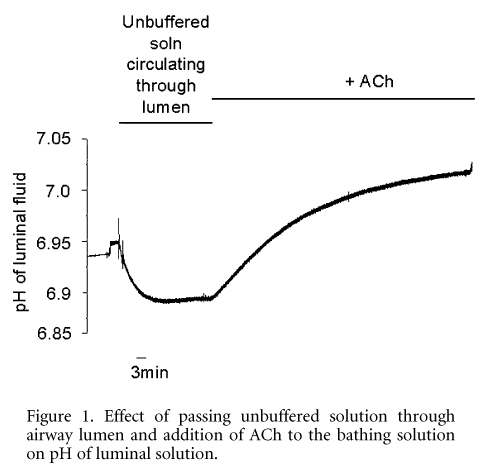Secretion of HCO3– by airway submucosal glands is essential for normal liquid and mucus secretion (Inglis et al. 1998). Since the liquid bathing the airway surface is acidic, we have proposed that the surface epithelium may acidify HCO3–-rich glandular fluid. The aim of this study was to investigate the mechanisms by which intact distal airways modify pH of luminal fluid. Porcine distal bronchi were isolated from humanely killed pigs, cannulated in a bath containing HCO3–-buffered solution and perfused (3 ml min-1) with similar solution, in which NaCl replaced NaHCO3–, which was lightly buffered (buffer capacity 0.6 mM pH unit-1) with KH2PO4 and NaOH to pH ~7, gassed with 100 % O2 to eliminate dissolved CO2 and stirred vigorously. The pH of this circulating luminal solution (10 ml) was monitored continuously. A luminal microelectrode was used to monitor transepithelial potential difference (PD) (Inglis et al. 1996). Upon perfusion through the airway lumen pH initially fell by 0.053 ± 0.005 pH units ([H+] increase 1.56 ± 0.19 mmol h-1 (mean ± S.E.M., n = 22)) before stabilising (see Fig. 1).
Acetylcholine (ACh, 10 mM), a gland secretagogue, increased pH, consistent with HCO3– secretion (see Fig. 1). Treatment with DMA (100 mM), a Na+-H+ exchanger inhibitor that inhibits gland HCO3– secretion (Inglis et al. 1998), significantly reduced the rate of alkalinisation induced by ACh (from 0.103 ± 0.023 to 0.028 ± 0.023 pH units h-1, n = 8, P < 0.05, Student’s paired t test used throughout). Removal of HCO3– and CO2 from the bathing solution and treatment with acetazolamide (1 mM) also significantly reduced ACh-induced alkalinisation (0.054 ± 0.006 to 0.0084 ± 0.0008 pH units h-1, n = 4, P < 0.05). Bumetanide (100 mM), which inhibits Cl– secretion, significantly increased both resting and ACh-stimulated rates of alkalinisation, consistent with earlier studies suggesting that HCO3– secretion is increased after Cl– secretion is inhibited (Inglis et al. 1996). Treatment with NPPB (300 mM) to block the anion channel thought to be required for both Cl– and HCO3– secretion significantly inhibited ACh-induced alkalinisation (0.099 ± 0.024 to 0.023 ± 0.0009, n = 7, P < 0.05). ACh evoked a depolarisation that was unaffected by DMA, bumetanide or HCO3– removal but was abolished by NPPB.
These studies demonstrate that distal airways can both acidify and alkalinise luminal fluid. Stimulation of submucosal glands induces secretion of HCO3– by a mechanism that includes generation of intracellular HCO3– and concomitant efflux of H+ by Na+-H+ exchange to maintain intracellular pH, and secretion of HCO3– through NPPB-sensitive anion channels. Secretion of HCO3– is increased following inhibition of Cl– secretion.
This work was supported by The Wellcome and Tenovus Trusts.
All procedures accord with current UK legislation.

